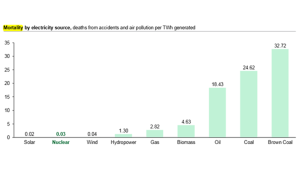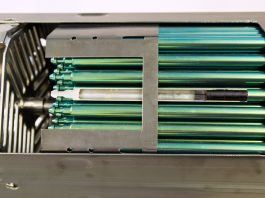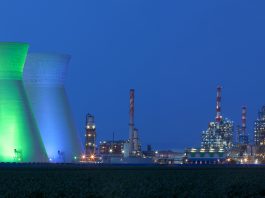Virginia Commonwealth University discusses the importance of nuclear energy in achieving environmental and climate goals.
VCU has an opportunity to join the webinar for DOE Nuclear Commercial Liftoff and here is the general summary.
First key: Understanding the power of nuclear energy
Nuclear energy is a clean power powerhouse in the United States. Right now, it supplies about 20% of the country’s electricity and a whopping 45% of its carbon-free electricity.
This is thanks to a fleet of 94 reactors at 54 sites.
Unlike solar and wind, which come and go with the weather, nuclear power is always-on, providing the steady baseload electricity the grid needs to stay stable and meet peak demand.
Second key: Meet the small but mighty SMRs
Enter small modular reactors (SMRs), the next generation of nuclear power. With capacities between 50 and 350 MW, SMRs are perfect for replacing old coal plants and opening up new sites that couldn’t handle bigger reactors.
Sure, they might be a bit pricier per MW than their larger cousins, but SMRs offer flexibility and scalability that’s hard to beat.
Plus, their compact size and built-in safety features make them a great fit for everything from powering tiny towns to providing industrial process heat.
Third key: Look beyond the LCOE
The levelised cost of electricity (LCOE) is the go-to metric for comparing power sources, but it doesn’t give nuclear energy its due. Nuclear plants can run for 80 years or more, way beyond the 40-60 years factored into LCOE. That means lower costs per megawatt-hour in the long run. And let’s not forget that nuclear power’s always-available generation is key to meeting those peak demand periods the grid faces.
Nuclear energy can even provide the reliable, carbon-free steam industries needed to run certain processes. Think cement, chemicals, and oil extraction – nuclear could be the clean energy solution they’ve been waiting for.
Oh, and the air quality benefits of nuclear power? They’re huge. Switching from fossil fuels to nuclear could prevent thousands of air pollution deaths per gigawatt-year.
Fourth key: Learn from Vogtle, the nuclear energy success story
The Vogtle project in Georgia is now the largest clean energy site in the US, but its costs aren’t the norm for nuclear. The AP1000 design used at Vogtle is now proven, the supply chain is established, and builders have gained invaluable experience.
Future AP1000 projects will benefit from better construction methods, mass-produced components, and lessons learned at Vogtle. All this means the AP1000 will be an increasingly competitive choice for clean baseload power.
The bottom line
Nuclear energy is a clean, reliable, and powerful force in the US energy mix. As technology advances and we apply the lessons of past projects, its potential will only grow.
It’s time to embrace nuclear as a key player in our low-carbon future.
The growing demand for nuclear energy
Demand for clean, firm energy will only intensify in the coming decades. To reach net-zero emissions by 2050, the US will need to add at least 700-900 GW of such capacity.
Nuclear energy can help minimise the need for additional variable generation, energy storage, and transmission infrastructure, saving billions in capital expenditures. A diverse portfolio with both variable renewables and firm nuclear can balance output and ensure a reliable supply of electricity (see Fig. 1).

(Source: https://liftoff.energy.gov/wp-content/uploads/2024/10/LIFTOFF_DOE_AdvNuclear-vX7.pdf)
The US has joined over 20 countries in committing to triple nuclear energy capacity by 2050, recognising its essential role in meeting global climate goals. This international consensus underscores the importance of nuclear energy in limiting warming to 1.5°C and avoiding the worst impacts of climate change.
The nuclear value proposition
Nuclear energy offers a unique combination of benefits: it is clean, firm, and land-efficient, minimises transmission needs, has a major economic impact, and supports critical industrial applications.
No other energy source can match this value proposition. Nuclear power can grow the economy, create high-paying jobs, and stimulate local development, all while cutting greenhouse gas emissions.
For states and regions seeking to decarbonise their energy mix, nuclear is an indispensable tool.
Safety and waste management
Nuclear energy is the least carbon-intensive source of all, as shown in Fig. 2. With over 50 years of operational experience and the equivalent of hundreds of millions of miles travelled by the Naval Propulsion program, nuclear has demonstrated a safety record comparable to that of solar and wind, as illustrated in Fig. 3.

(Source: https://liftoff.energy.gov/wp-content/uploads/2024/10/LIFTOFF_DOE_AdvNuclear-vX7.pdf)
Next-generation designs incorporate passive cooling and other features that further enhance the already substantial safety margins. These advanced reactors can cool themselves for extended periods without electricity, eliminating the risk of a Fukushima-style accident.

(Source: https://liftoff.energy.gov/wp-content/uploads/2024/10/LIFTOFF_DOE_AdvNuclear-vX7.pdf)
Used nuclear fuel can be managed safely and securely. A 50-year-old plant’s waste would fit on a basketball court, and robust dry cask storage systems are in use at facilities across the country.
Permanent storage, while a political challenge, is no longer an engineering problem. The US Department of Defense has a long-term storage facility to receive nuclear waste from across the country. Finland has recently opened a permanent storage site for its commercial waste.
Failing to utilise nuclear energy would actually increase radioactivity in the environment, as nuclear power prevents the unregulated, unmonitored release of radioactive materials from fossil fuel extraction and use.
By choosing nuclear energy over fossil fuels, we can reduce our environmental footprint and create a cleaner, healthier world for future generations.









